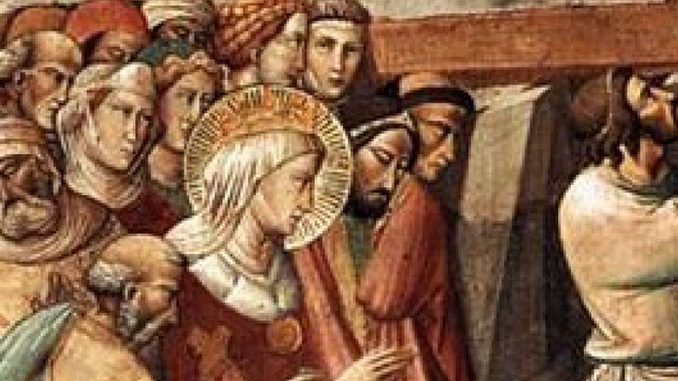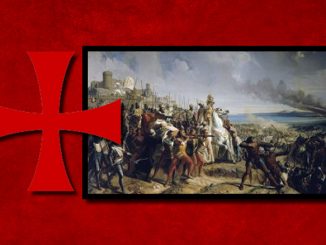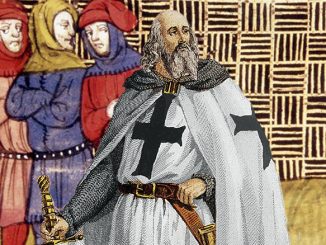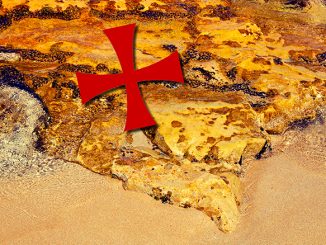
Above: The Finding of the True Cross, Agnolo Gaddi, Florence, 1380
One of the outcomes of the Crusades was the production of many religious relics. Among these alleged instruments of Divinity the more common ones were the bones of Saints and soil from various places referred to in the Bible. Of a more important nature were several heads said to be that of John the Baptist and the Crown of Thorns which was actually sold by King Baldwin II of Jerusalem to King Louis IX of France who built a shrine to house it. Of all the relics, none caused more furor and deaths than that of the so-called “True Cross.”
The True Cross is described as being part of the cross of Golgotha encased in gold and studded with priceless gems. The legend of the True Cross begins in the year 326 when it was allegedly discovered by the mother of Constantine I, the Empress Helena.
“In AD 326, Helena went on a journey to ancient Israel and selected with Macarius the sites of Christ’s birth at Bethlehem and at Jerusalem, the adjoining places of his tomb burial and Crucifixion, where she happened to discover three ancient crosses in a cavern, one of which was called the true cross.”
Jerusalem “The Endless Crusade by Andrew Sinclair
Now exactly how Helena determined which of the three discovered crosses was the one Jesus was crucified on is covered in Michael Grant’s book on the Roman Emperor Constantine:
“Here Bishop Macarius of Jerusalem came to Helena’s help, by undertaking, with a prayer for God’s help, to place a sick woman on each of the three crosses in turn, so that it could then be seen what happened to her on each of the three occasions. When she was placed on the first two crosses, nothing happened. Next, however, she was made to lie on the third cross, whereupon she was healed. That, it was concluded, must have been the True Cross on which Jesus met his death.”
Constantine The Great – The Man And His Times by Michael Grant
Upon Helena’s return, the True Cross was kept in the Church of the Holy Sepulcher in Jerusalem until the year 614 when Chrosroes II of Persia moved it to his own land when he captured Jerusalem. Thirteen years later the Roman Emperor Heraclius defeated Chrosroes and retook the relic, which he at first placed in Constantinople and later, took back to its original Jerusalem. The True Cross is believed to have been hidden by the Christians in 1009 C.E. and remained hidden for ninety years only to be produced in 1099 during the First Crusade.
It remained in Christian hands until the Battle of Hattin in 1187, when the Moslem leader Saladin captured the relic. It is believed that Saladin after the Battle of Hattin and the capture of Jerusalem, would ride his horse through the streets with the Holy Relic dragging behind his mount’s tail.
“After The Horns of Hattin, Saladin was master of the Moslem world, and rode through the streets of Damascus with the captured True Cross tied to his horse’s tail and dragging in the dust.”
The Crusades byHenry Treece 1962
Despite the valiant efforts of Richard I during the Third Crusade, the True Cross remained in Moslem hands. The beam itself disappeared, but fragments of the cross that came off were collected and brought back to Europe after the Crusades. Of course, If all the fragments were put back together then several hundred crosses could have been made, as many of the pieces were most certainly fakes.
Although the so named True Cross was an inspiration and death sentence to many brave men of the time, no trace of the relic is believed to exist today. Was this focal point of the Crusaders, the True Cross as it was called. Perhaps we will never know. The important thing remains that for those soldiers who took up the cause of the Crusades, it was real enough to die for.
About Us
TemplarHistory.com was started in the fall of 1997 by Stephen Dafoe, a Canadian author who has written several books on the Templars and related subjects.
Read more from our The Crusades Archives – Templar History



